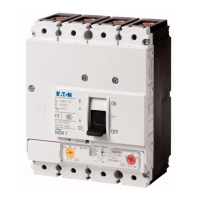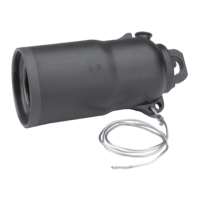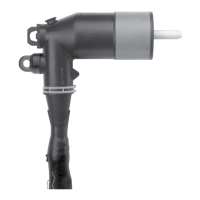Preventive maintenance tapping
Preventive Maintenance Tapping (PMT™) will automatically
operate the tap-changer according to user-configured
parameters. Under certain operating conditions, load tap-
changer contacts can become susceptible to coking. The
PMT feature will operate the tap-changer to wipe the
contact blades and prevent build-up of carbon. There are
two different types of preventive maintenance tapping
available: PMT Mode A and PMT Mode B.
PMT Mode A
When enabled the control monitors tap position and, if it
remains on any single tap position for a user-defined period
of time (Time Delay, FC 302), the control will automatically
raise the tap-changer one position, lower the tap-changer
two positions, and then raise the tap-changer one position.
When PMT Mode A is performed on a Quik-Drive tap-
changer, this entire operation will take approximately one
second. The user can monitor how much time is left prior
to the maintenance tapping being performed at Countdown
Delay, FC 301. To sample how the PMT Mode A functions,
the user can use Issue Test, FC 303.
PMT Mode B
When enabled, the control monitors tap position and, if it
does not pass through neutral for a user-defined period of
time (Time Delay, FC 322), the control will automatically tap
through and past neutral one position. This operates and
wipes the blades of the reversing switch. It then returns
the tap-changer to the original tap position. Due to the
possible large fluctuation in voltage while maintenance is
being performed, there are more configuration points in
PMT Mode B than in Mode A. The user can determine the
time of day that PMT Mode B is allowed to operate, so that
maintenance can be performed at night. To limit the amount
of allowable voltage-swing when performing maintenance,
the user can input the maximum deviation. Also, the user can
input a current limit so that maintenance is only performed
under light load conditions. Additionally, a master slave mode
is available so multiple units can act at once to keep the
supply balanced for three-phase loads that are sensitive to
imbalance. The user can monitor how much time is left prior
to the maintenance tapping being performed at Countdown
Delay, FC 321. To sample how the PMT Mode B functions,
the user can use Issue Test, FC 328.
Duty cycle monitor
The Duty Cycle Monitor calculates the amount of life used
for each arcing surface contact on the voltage regulator
Quik-Drive tap-changer. The control uses the metering
values, such as current, voltage, power factor, and tap
position, and a detailed data on the internal design of the
voltage regulator to calculate the interrupting current and
recovery voltage. This is then related to the test data for the
appropriate Quik-Drive tap-changer. The Duty Cycle Monitor
functions only on voltage regulators with a Quik-Drive tap-
changer.
FC 333 displays the worst-case value of life used, expressed
as a percentage, to the third decimal point. This value
may be used to generate two different Data Alarms. The
first DCM Data Alarm is intended to be configured so that
maintenance may be scheduled. The suggested setting
is 75%. The second Data Alarm is intended to be set at a
higher level, the suggested setting is 90%, in order to notify
the user that a service outage due to contact failure may be
imminent. For more information on Alarms, see the Alarms
topic in this section of the manual.
A detailed percentage of life-used for each arcing contact
is also available and can be viewed using ProView NXG
software. When replacing a control on an existing voltage
regulator, ProView NXG software must be used to enable
and configure the Duty Cycle Monitor feature. Configuration
values programmed in the software for the specific voltage
regulator include the design number and an estimation of
the amount of life already used.
ote:N Duty Cycle Monitor is active only on Eaton's Cooper
Power series regulators with Quik-Drive
tap-changers.
Leader/follower scheme
The Leader/Follower Scheme is an electronic scheme
designed to coordinate the operation of two or three
individual single-phase step voltage regulators. This feature
is primarily used by utilities and others needing three-phase
voltage regulation within certain parameters.
A fiber optic intelligent loop scheme (LoopShare) is used
between controls providing the communications necessary
between phases to initialize a tap change and provide
positive feedback in maintaining regulation within the
desired parameters. The status and settings for LoopShare
are found at FC 860 through FC 863. As a result of the
communications between all phases, access to certain
data from all phases is available at the display of all controls
involved and by using ProView NXG software.
If configured as a Leader or Follower device, the CL-7
control can be operated in one of two Ganged modes or
a Group Coordinated mode. All configuration and setting
values associated with the connected equipment must be
configured separately for all connected voltage regulators.
Leader/Follower Operation works on the understanding that
all equipment connected and run in the Leader/Follower
configuration must maintain communications with the
operating group.
This scheme can also be used for paralleling substation
voltage regulators with a set of power transformers used for
increasing capacity and providing a backup for maintaining
regulated power. For more details on the various Leader/
Follower schemes and configuring the feature, see
document MN225015EN CL-7 Regulator Control ProView
NXG Software Programming Guide.
154
INSTALLATION, OPERATION, AND MAINTENANCE INSTRUCTIONS MN225003EN April 2018
CL-7 Voltage Regulator Control

